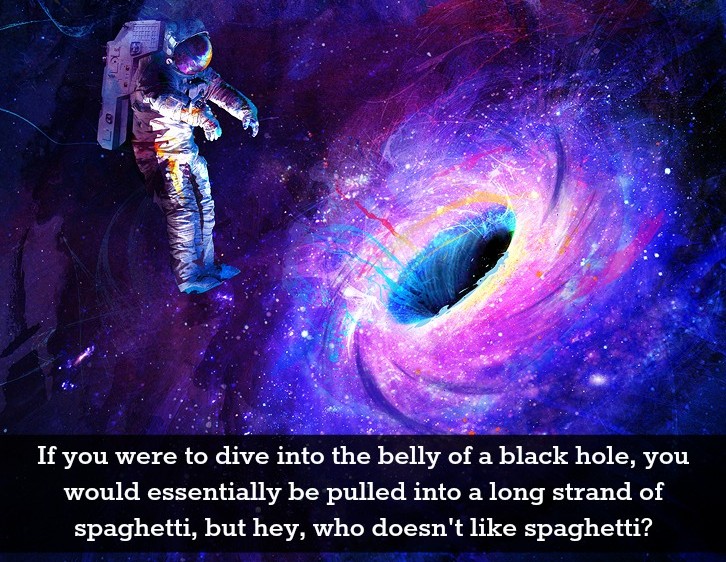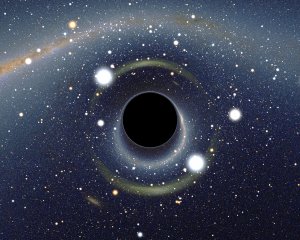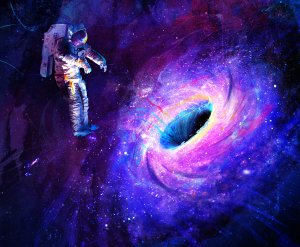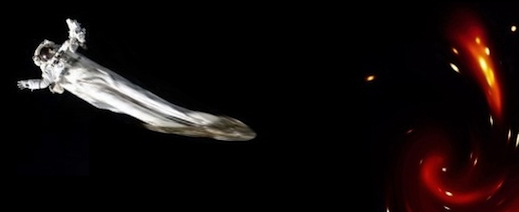

Do you like spaghetti? If your answer is ‘yes,’ why not become what you love? You can…if you dive on into the belly of a black hole. For you are crunchy and taste good with meatballs and marinara sauce (figuratively speaking, of course).
What are we talking about? Well, as you may know, a black hole is formed when a massive star, one that is many times larger than our sun, burns up all of its fuel and reaches the end of its life, with its core collapsing in on itself. When this happens, the core shrinks to a fraction of its original size and forms a single point that is so dense not even light can escape its gravitational pull. This ‘point,’ called a singularity, is essentially a baby black hole. While the black hole is new, it cannibalizes the remaining stellar material. This all happens so fast that the star doesn’t even know it’s dead yet. It takes in so much gas and energy at such a rapid pace that the star ‘coughs’ and expels huge, pointed beams of energy from its poles before forming a black hole, this is called a called gamma-ray bursts. This all happens in milliseconds! Finally, the star explodes and goes supernova.
When this happens, it blasts out more energy in one second than our Sun will produce over the course of its entire lifetime.
Black holes can come in many different sizes: They can be microscopic (micro), very small, medium-sized (stellar-mass), and finally we have supermassive black holes. To explain a little further: small black holes, like IGR J17091-3624, exhibit characteristics that can be likened to a celestial form of vampirism. They have been found siphoning the life-source (gas) of neighboring stars, allowing them to bulk up. Yet, they remain much smaller than their counterparts, weighing in at about three times the mass of our Sun. Medium (or intermediate) sized black holes, like HLX-1, are thought to be the building blocks of supermassive black holes. They usually weigh around 20,000 solar masses. Supermassive black holes like Sagittarius A* (the black hole found at the center of the Milky Way), are formed primary by the accretion of matter and by the merger of other high-mass black holes. These black holes are billions of solar masses and are believed to be a key element in galaxy formation.
DIVING INTO THE BELLY OF A BLACK HOLE:

Now, let’s say that you were going to take one for the team (that team being the scientific community and young wannabe astronauts) and throw yourself into a black hole (for science!). Before you venture out into space to meet your demise, you should make sure to bring a watch along with you (a Rolex preferably, assuming you want to go out in style), as it will be one of the defining moments of your trip. As you exit your ship and continue floating through space, being pulled by the intense gravity of the black hole, you start to approach what is called the event horizon. I’m not talking about “event horizon” and in the really bad horror movie; this is the real thing. The event horizon is the point of no return for you (and pretty much anything unlucky enough to get drawn in by the immense gravity well of a singularity).
Remember that fancy watch you put on? It’s about to come in handy. Let’s say you enter the event horizon at 11:59 AM. Even though it does not appear this way to the people observing you (time ticks on just as it normally would for them), you notice that the watch you are wearing starts to slow down; every second starts to take longer and longer to come to fruition. As your watch inevitably ticks down to 11:59:58, the last second would almost take an eternity to pass (okay, so your frame of reference wouldn’t actually allow you to realize that it was taking ages and ages, but that second to you would actually span a lot longer). Why is this? Because when you get that close to a black hole, time, due to the intense gravity of the black hole, starts to warp and slow down (we call this time dilation). You can thank Einstein and his theory of general relativity for bringing that little nugget of information to light.
GENERAL RELATIVITY SAYS:
As you get closer to the event horizon, and inch closer to the black hole itself, you might start to feel a little pinch. Don’t be alarmed (okay.. it’s normal to be a little bit alarmed), this is just your body starting to stretch and tear apart. Again, this pull is the direct consequence of the mind bogglingly strong gravitational pull of the black hole. You would initially experience this pulling sensation at your toes. And as your toes stretched, you’d start to gradually feel the pull extend to your legs, your thighs, your mid-section, etc. Your lower half would be accelerating towards the black hole faster than your upper half. That is to say, the gravity acting on your toes would be much stronger than the gravity acting on your head (assuming you were falling feet-first). As the process continues, you will eventually be torn apart similar in mechanics to squeezing toothpaste from a tube. Eventually, all of the cells in your body will be torn into a line of disconnected atoms. Then, every atom begins to separate until they are nothing but their basic components. No one knows for certain what happens to those atoms once they reach the center of a black hole, but physics tells us that those atoms are likely there to stay.
This whole process of being stretched and torn into atoms is called spaghettification.

A prime example of spaghettification is the large gas cloud that recently got too close to the supermassive black hole in the center of our Milky Way. As the cloud was affected by the black hole’s gravity, it started to stretch and funnel in towards the black hole. This video clip shows the gas cloud, as observed by ESO’s Very Large Telescope, being ripped apart and spaghettified by the black hole.
Stephen Hawking wrote in his book A Brief History of Time (1988) that if you got too close to the black hole, one would be “stretched like spaghetti.” Although you would not be alive to experience it, your atoms would become a long tube, that resembled a certain noodle, traveling towards the singularity.
Now, just add a little marinara sauce and you’ll have yourself a nice Italian meal; a la Black Hole.
ADDITIONALLY:
It has been speculated that if a black hole is sufficiently large enough (say, with the diameter of our solar system), you might actually be able to survive the spaghettification process long enough to witness something truly spectacular. In short; the larger the black hole, the less extreme its surface is. Therefore, if a black hole were large enough, it would theoretically be possible to maintain your structural integrity. Given the basic tenets of general and special relativity – that the faster objects move through space, the slower they move through time – we can deduce that every object (including you) that was ever swallowed by the black hole would feel the effects of the time dilatation brought on by the curvature of space/time. The objects that hurdled into the black hole before you did would experience a larger time dilation than you..
Conversely, the objects that will enter it after you will experience less time dilation. Thus, if you’re able to look forward toward the black hole as you’re falling into it at relativistic speeds, you would see every object that has fallen into it in the past. If you look backward, you’d be able to see everything that will ever fall into the black hole after you. You’d be able to see the entire history of that particular spot in the cosmos from the inception of the universe, until the end of time (at least until Hawking radiation causes the black hole to evaporate). Hypothetically, of course.
Taking it a step further, we discussed what it would be like to spend a day (or eternity) in a black hole. You can read our article here.
(Additional commentary by Jaime Trosper)